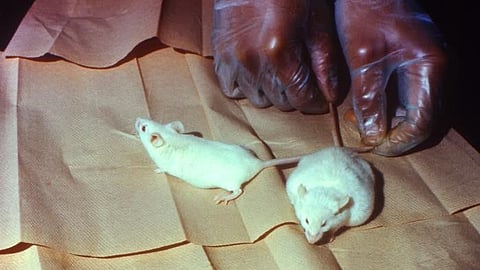“The laboratory house mouse has maintained a standard 40-chromosome karyotype — or the full picture of an organism’s chromosomes — after more than 100 years of artificial breeding,” said co-first author LI Zhikun, researcher in the Chinese Academy of Sciences (CAS) Institute of Zoology and the State Key Laboratory of Stem Cell and Reproductive Biology. “Over longer time scales, however, karyotype changes caused by chromosome rearrangements are common. Rodents have 3.2 to 3.5 rearrangements per million years, whereas primates have 1.6.”
Such small changes may have big impacts, according to LI. In primates, the 1.6 changes are the difference between humans and gorillas. Gorillas have two separate chromosomes whereas in humans they are fused, and a translocation between ancestor human chromosomes produced two different chromosomes in gorillas. At an individual level, fusions or translocations can lead to missing or extra chromosomes or even to such diseases as childhood leukemia.
While the consistent reliability of the chromosomes is good for understanding how things works on a short-time scale, the ability to engineer changes could inform genetic understanding across millennia, including how to correct misaligned or malformed chromosomes, LI said. Other researchers have successfully engineered chromosomes in yeast but attempts to move the techniques to mammals have not been fulfilled.
According to co-first author WANG Libin, researcher with CAS and the Beijing Institute for Stem Cell and Regenerative Medicine, the difficulty is that the process requires deriving stem cells from unfertilized mouse embryos, meaning the cells only contain one set of chromosomes. In diploid cells, there are two sets of chromosomes that align and negotiate the genetics of the resulting organism. Called genomic imprinting, this is where a dominant gene may be marked active, while a recessive gene is marked inactive. The process can be scientific manipulated, but the information has not stuck in previous attempts in mammal cells.
“Genomic imprinting is frequently lost, meaning the information about which genes should be active disappears, in haploid embryonic stem cells, limiting their pluripotency and genetic engineering,” WANG said. “We recently discovered that by deleting three imprinted regions, we could establish a stable sperm-like imprinting pattern in the cells.”
Without the three naturally imprinted regions, the researchers’ engineered imprinting pattern could take hold, allowing them to fuse specific chromosomes. They tested it by fusing two medium sized chromosomes — 4 and 5 — head to tail and the two largest chromosomes — 1 and 2 — in two orientations, resulting in karyotypes with three different arrangements.


